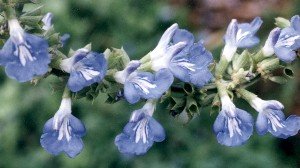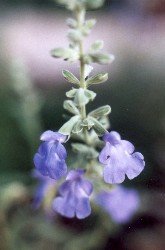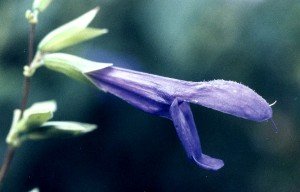|
An article about red salvias, written earlier, begs the question, "What about the other colors?" While the pink and lavender blossomed salvias are covered in "Other Salvias," this article deals with the blue ones. All the salvias here are perennials, but some are more suited to our area than others.
 Our attempt to grow bog sage (Salvia uliginosa) was a rather dismal failure. This import from South America, pictured at left, has stunning flowers and spreads aggressively by means of underground runners if conditions are good. I suspect this means plenty of water, especially during the hottest part of our summer, as the plant I had grew feebly, produced some nice flowers, then wilted away to nothing. I've seen it growing in other gardens in this area, but it needs copious water and still doesn't deal well with the heat. It could probably do just fine in a slightly cooler climate.
Our attempt to grow bog sage (Salvia uliginosa) was a rather dismal failure. This import from South America, pictured at left, has stunning flowers and spreads aggressively by means of underground runners if conditions are good. I suspect this means plenty of water, especially during the hottest part of our summer, as the plant I had grew feebly, produced some nice flowers, then wilted away to nothing. I've seen it growing in other gardens in this area, but it needs copious water and still doesn't deal well with the heat. It could probably do just fine in a slightly cooler climate.
 Luckily, we've had other blue sages that are well suited to our soil, temperature, and water resources. One that is quite pretty is a native as well. The photo at right shows giant blue sage (Salvia azurea), a tall, upright plant that only slowly spreads underground. The color of the blossoms is not as deep as some other sages, but is closer to sky blue. The sturdy stems grow about 3 - 4 feet tall and do not branch very much. Leaves are long and thin and arranged symmetrically up the entire stem. Other names for this sage are pitcher sage and azure blue sage. While it grows okay in a rather dry, rocky location, the seeds from this salvia don't seem to germinate easily and we still just have only one small clump.
Luckily, we've had other blue sages that are well suited to our soil, temperature, and water resources. One that is quite pretty is a native as well. The photo at right shows giant blue sage (Salvia azurea), a tall, upright plant that only slowly spreads underground. The color of the blossoms is not as deep as some other sages, but is closer to sky blue. The sturdy stems grow about 3 - 4 feet tall and do not branch very much. Leaves are long and thin and arranged symmetrically up the entire stem. Other names for this sage are pitcher sage and azure blue sage. While it grows okay in a rather dry, rocky location, the seeds from this salvia don't seem to germinate easily and we still just have only one small clump.
 Mexican sage (Salvia mexicana) is a two foot tall clumping plant. Growing in partial shade seemed to suit it well, and it only wilted when the soil became extremely dry. The leaves are especially attractive as they are dark green with lighter colored veins. This was our first year trying this species. Although the plant flowered for only a relatively brief time during the late summer, it did produce plenty of blossoms, which are large and very deep blue. The color and size are about the same as the blossoms of majestic sage, which happens to be growing right next to it. The two types of flowers do have slight differences, but they are only seen close up.
Mexican sage (Salvia mexicana) is a two foot tall clumping plant. Growing in partial shade seemed to suit it well, and it only wilted when the soil became extremely dry. The leaves are especially attractive as they are dark green with lighter colored veins. This was our first year trying this species. Although the plant flowered for only a relatively brief time during the late summer, it did produce plenty of blossoms, which are large and very deep blue. The color and size are about the same as the blossoms of majestic sage, which happens to be growing right next to it. The two types of flowers do have slight differences, but they are only seen close up.

Majestic sage (Salvia guaranitica) is another South American import and has some of the biggest, deepest blue flowers of any salvia. Also called blue anise sage and Brazilian sage, this is a rather popular garden plant, with a cultivar available in which the calyxes are black colored.  On our plants, they are green. Although rather slow growing, majestic sage seems to do okay with the heat and only moderate water. So far our plants have never grown very big or branched much. They do bloom periodically throughout the summer even though they are in the shade. On our plants, they are green. Although rather slow growing, majestic sage seems to do okay with the heat and only moderate water. So far our plants have never grown very big or branched much. They do bloom periodically throughout the summer even though they are in the shade.
One of the most popular salvias in this area is a hybrid called indigo spires (Salvia farinacea x longispicata). It is a hardy plant that grows to about 3 feet tall and just as wide. I've found that putting a support around the plant in the early spring is the only way to keep it partly upright, as it just gets bigger and bigger all season long, with the weak stems falling over as it keeps spreading. The flowers are fabulous and are almost purple. While they are smaller than majestic or Mexican sage blooms, they are more plentiful and the racemes get longer and longer as the plant keeps blooming throughout the summer. It would probably do well to be cut back during mid-summer, when the blossoming is at a minimum, but I often just gather up the stems and push them back within the wire supports. During the winter, indigo spires barely dies back, being one of the first plants to sprout in the spring. This plant is especially attractive to insects, which are always buzzing around its blossoms.
|
 Our attempt to grow bog sage (Salvia uliginosa) was a rather dismal failure. This import from South America, pictured at left, has stunning flowers and spreads aggressively by means of underground runners if conditions are good. I suspect this means plenty of water, especially during the hottest part of our summer, as the plant I had grew feebly, produced some nice flowers, then wilted away to nothing. I've seen it growing in other gardens in this area, but it needs copious water and still doesn't deal well with the heat. It could probably do just fine in a slightly cooler climate.
Our attempt to grow bog sage (Salvia uliginosa) was a rather dismal failure. This import from South America, pictured at left, has stunning flowers and spreads aggressively by means of underground runners if conditions are good. I suspect this means plenty of water, especially during the hottest part of our summer, as the plant I had grew feebly, produced some nice flowers, then wilted away to nothing. I've seen it growing in other gardens in this area, but it needs copious water and still doesn't deal well with the heat. It could probably do just fine in a slightly cooler climate.
 Luckily, we've had other blue sages that are well suited to our soil, temperature, and water resources. One that is quite pretty is a native as well. The photo at right shows giant blue sage (Salvia azurea), a tall, upright plant that only slowly spreads underground. The color of the blossoms is not as deep as some other sages, but is closer to sky blue. The sturdy stems grow about 3 - 4 feet tall and do not branch very much. Leaves are long and thin and arranged symmetrically up the entire stem. Other names for this sage are pitcher sage and azure blue sage. While it grows okay in a rather dry, rocky location, the seeds from this salvia don't seem to germinate easily and we still just have only one small clump.
Luckily, we've had other blue sages that are well suited to our soil, temperature, and water resources. One that is quite pretty is a native as well. The photo at right shows giant blue sage (Salvia azurea), a tall, upright plant that only slowly spreads underground. The color of the blossoms is not as deep as some other sages, but is closer to sky blue. The sturdy stems grow about 3 - 4 feet tall and do not branch very much. Leaves are long and thin and arranged symmetrically up the entire stem. Other names for this sage are pitcher sage and azure blue sage. While it grows okay in a rather dry, rocky location, the seeds from this salvia don't seem to germinate easily and we still just have only one small clump.
 Mexican sage (Salvia mexicana) is a two foot tall clumping plant. Growing in partial shade seemed to suit it well, and it only wilted when the soil became extremely dry. The leaves are especially attractive as they are dark green with lighter colored veins. This was our first year trying this species. Although the plant flowered for only a relatively brief time during the late summer, it did produce plenty of blossoms, which are large and very deep blue. The color and size are about the same as the blossoms of majestic sage, which happens to be growing right next to it. The two types of flowers do have slight differences, but they are only seen close up.
Mexican sage (Salvia mexicana) is a two foot tall clumping plant. Growing in partial shade seemed to suit it well, and it only wilted when the soil became extremely dry. The leaves are especially attractive as they are dark green with lighter colored veins. This was our first year trying this species. Although the plant flowered for only a relatively brief time during the late summer, it did produce plenty of blossoms, which are large and very deep blue. The color and size are about the same as the blossoms of majestic sage, which happens to be growing right next to it. The two types of flowers do have slight differences, but they are only seen close up.

 On our plants, they are green. Although rather slow growing, majestic sage seems to do okay with the heat and only moderate water. So far our plants have never grown very big or branched much. They do bloom periodically throughout the summer even though they are in the shade.
On our plants, they are green. Although rather slow growing, majestic sage seems to do okay with the heat and only moderate water. So far our plants have never grown very big or branched much. They do bloom periodically throughout the summer even though they are in the shade.